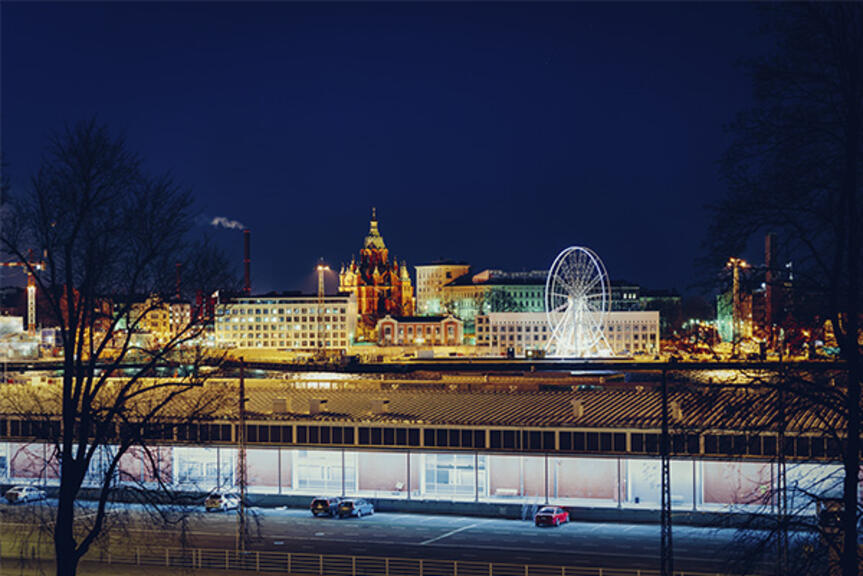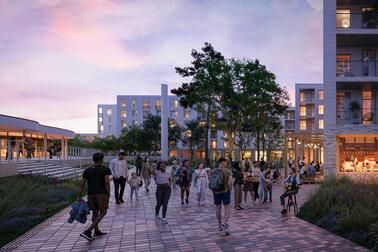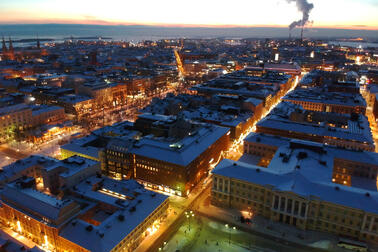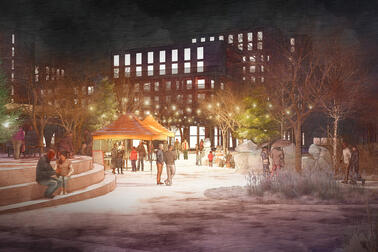
An appealing city centre is vital for Helsinki. The development and planning of the centre area will be advanced substantially during the coming spring. In its meeting on 11 January, the City Board will consider proposals related to the city centre vision, the development of a pedestrianised city centre and the centralisation of harbour operations. A quality and concept competition pertaining to the shore zone reaching from Olympia terminal to the Market Square is also to be launched in spring 2021.
An attractive city centre is a visiting card and crucial for Helsinki. The aim is that the centre of Helsinki be a vital and attractive focal point for commercial services, events, well-being and civic activities. The favourable development of the centre area is a critical success factor for the vitality of the entire city, particularly in the light of the coronavirus crisis’ impacts.
The development of the centre area can be divided into several interdependent topics. The city centre vision, the proposals on the development of a pedestrianised city centre and the centralisation of harbour operations as well as the development of the South Harbour area jointly make up a substantial whole.
”The need for developing the city centre has long been understood in the city and was widely discussed four years ago, as the city strategy was written. The coronavirus pandemic has further added to the importance and urgency of this development work. The agenda put forward now is very extensive, with strongly interlinked parts. Aside from the physical development of the urban environment, the agenda concerns the vitality, dynamism and functionality of Helsinki’s city centre in a situation in which, for example, the development of intelligent traffic and digitalisation shape urban life at a pace never seen before. Once implemented, these proposals will shape the centre of Helsinki and its development well into the future,” says Mayor Jan Vapaavuori.
City centre land use vision describes desirable future of city centre
The City Board will be presented with a Helsinki centre vision - policies for planning land use and traffic in the city centre. Upon adoption, this vision can be used as a basis for further planning. These indicative policies will be a starting point for the planning of the blocks and the park and street areas of the city centre.
The centre vision has been prepared jointly with citizens, businesses and other stakeholders and experts from different sectors. It covers Helsinki’s residential and commercial city centre area. In addition to background information and a description of the objective, the vision contains 20 development policies that guide the long-term development of an attractive city centre.
The vision, its knowledge base and the results of the interaction will be utilised for updating the city centre’s detailed plans and in other ongoing and coming land use-related projects, making programme processes smoother and laying out a common path towards the future.
According to the vision, Helsinki’s city centre, its user numbers and area of influence will grow. In the future, the core of the capital will be an internationally attractive business hub, Finland’s most important job concentration area and, simultaneously, a leading cultural hub in the Nordic Countries. The city centre will be vibrant and attractive in every hour of the year.
It will offer a functioning environment and versatile options for residents, jobs and services. The shores will be opened up to the residents and will receive new facades that supplement the traditional maritime landscapes in a balanced manner. New constructions will be fitted into the environment artfully. Culture and tourism services will spread out further, even into the archipelago.
Change trends and climate risks will be tackled proactively. The structure of the city centre will support and prioritise an environmentally friendly way of life. The pedestrianised city centre will be a publicly open, functional, safe and clean place for being as opposed to transit; rails will connect it both regionally and to an international network of cities.
Cosy urban spaces as the aim of city centre development
The City Board will consider the policies pertaining to a pedestrianised city centre. The proposal is to extend the city centre’s mainly pedestrianised area through the provision of more versatile functions and through enhancing the quality of urban space. In the area of Pohjoisesplanadi and Aleksanterinkatu, the idea is to increase the number of spaces opening towards the street and to improve transverse pedestrian paths. A more pedestrian-friendly layout of Fabianinkatu is also proposed.
South of Esplanadi, the agenda proposes an improved pedestrian connection towards Kasarmitori in Fabianinkatu and Kasarmikatu streets, taking advantage of the absence of the harbour’s truck traffic. In addition, the attractiveness of Kasarmitori and the operating conditions of businesses are to be improved, while the pedestrian connection to the market is to be improved by restricting car traffic in Fabianinkatu or in Pohjoinen Makasiinikatu. Pedestrian connections shall also be improved towards Makasiiniranta, and a shore route is to be developed in the environment of the South Harbour and in Katajanokka.
An exceptional number of projects are pending in the area of Helsinki’s city centre – if implemented, these will increase the attractiveness and vitality of the centre. The New Student House and the former hotel Seurahuone are in the process of being transformed into a new five-star hotel. Neighbouring Kaivopiha and Sokos Hotelli Vaakuna will be renovated in Kaivokatu. New facility construction opportunities will also emerge at Elielinaukio.
Further major city development projects include the surroundings of Hietalahti basin, the blocks of Katajanokanlaituri and the western part of the South Harbour. Significant development projects are also going on in Hakaniemi.
In connection with the planning and implementation of these projects, conditions will be created for the development of public environment and for the improvement of its quality. For example, ground floors, opening towards the street, maintenance integration into the buildings or underground facilities and the placement of vehicle ramps into the buildings will be considered in planning and implementation.
Helsinki also wants to promote wider use of the city centre’s service tunnel. Preparation will take place in interaction with the real estate owners and other operators within the scope of effect of the tunnel. A proposal on the promotion measures will be introduced to the City Board for adoption during 2021. Planning related to the improvement of underground pedestrian connections is also under way. The development principles will be specified in the underground city plan. It will be introduced for decision-making during 2021.
Centralisation of harbour operations into West Harbour proposed
According to the relevant change proposal, operations of the Port of Helsinki are to be centralised into the West Harbour. Passenger car ferry traffic would cease in the South Harbour but continue in Katajanokka.
With the elimination of the current passenger car ferry traffic from the South Harbour area, space will be freed up for a higher-quality urban environment in terms of both urban landscape and landscape in general. The service traffic route and the location of the shore route can also be reevaluated.
The aim of Helsinki is to ensure the operating conditions of the Port. From the viewpoint of Helsingin Satama Oy and its customers, the solution opens up a long-term development prospect for harbour operation and traffic. A harbour tunnel between the West Harbour and Länsiväylä is planned to be implemented as an investment by the Port, enabling the extension of the operations of the West Harbour and the smooth arrangement of harbour traffic.
The capacity of the West Harbour area is to be increased through extending the area by filling the sea, which allows for a significant part of the passenger car ferry traffic of Katajanokka to be moved to the West Harbour. The solution is indispensable not only because of the traffic of the West Harbour, but also because of the Port’s huge overall impact on the Finnish economy – ca. 4.1 billion euros annually. The Port plays a key role in the functionality and security of supply of Finnish external trade logistics, with the value of the goods transiting through the harbour accounting for about 40–50 per cent of the value of Finnish sea freight. Passengers transiting through the Port of Helsinki generate almost 700 million euros of revenue annually for the Metropolitan Area.
The final decision on the Port operation changes will be made by the City Council. If the changes are adopted, Helsingin Satama Oy will launch the preparations of a development programme to implement the required investments.
Competition to find the best overall South Harbour plan
On 9.11.2020, the City Board reserved an area in the South Harbour for a quality and concept competition. The aim is to change the area currently used mainly for harbour terminal operations and parking into an attractive, pedestrianised public urban space connecting the Market Square with Kaivopuisto and giving access to the sea.
The main objective of the Makasiininranta quality and concept competition is to produce an implementable overall land use plan for use as the basis for detailed planning. The plan should be of high quality and functionality and implement the city’s objectives in terms of land use, urban landscape and other aspects. It must be considered in the competition that the area extending from the old market hall to Olympia Terminal comprises a part of the national landscape of maritime Helsinki, a built cultural environment of national significance and a Unesco world heritage protection zone.
The aim is to launch the two-phase quality and concept competition in March 2021. The competition is intended for operators of the construction and real estate sector. It is possible to propose culture, service, business and other facility construction into the area, but residential construction is excluded. The competition scope also contains the area planned for the architecture and design museum. The actual implementation of the Museum will be decided on at a later stage based on a separate architecture competition. The design principles of the area and the competition programme will be decided on by the Urban Environment Committee in early 2021. The design principles will be prepared in interaction with the residents and other stakeholders.
The competition entries will be opened for public display and consultation in both phases of the competition. The entries will be evaluated based on the quality of the presented plans. Particular attention will be paid on the quality of the plans in terms of urban landscape, the functionality and implementability of the concept, the quality of the pedestrian environment and urban space as well as on solutions contributing to the implementation of the Carbon-neutral Helsinki 2035 programme.
The detailed planning of Makasiiniranta and Olympiaranta will start with a participation and evaluation plan in late January 2021. Participation in the development of the area is possible at several stages; the area’s design principles will be opened for display and consultation in the Kerro kantasi service on 25 January at kerrokantasi.hel.fi. Once the detailed plan project has been started, reports and draft plans related to the planning of the area will also be displayed in the map service.
Upon conclusion of the Makasiiniranta competition, the City Board’s Economic Development Division will decide on a development reservation for the competition’s winner approximately during 2022, after which a draft detailed plan will be drawn up. It is possible that the competition will be followed by separate, more detailed architecture competitions regarding each site in the area.
More information
The agendas and records of the City Board meeting of 11 January 2021 (in Finnish)
More information on planning(Link leads to external service)
A map of urban development projects in the city centre (pdf)
A map of urban development projects in the city centre (png)
Photo: Jussi Hellsten, Helsinki Marketing


